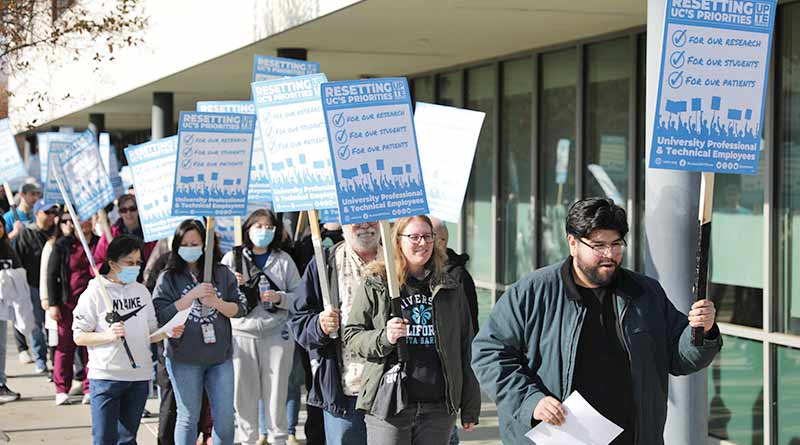UC Davis workers sound alarm on staffing at critical lab
By Sheri Williams
Union workers at the California Animal Health & Food Safety Lab System (CAHFS) at UC Davis are raising the alarm about severe understaffing and unsafe conditions that jeopardize critical testing for diseases like Highly Pathogenic Avian Influenza (H5N1).
On December 11, these essential workers, represented by UPTE, held an informational picket to call attention to the burnout and turnover crisis in their lab.
“The fight that CAHFS workers are going through is what we mean when talking about resetting UC’s priorities to serve all Californians,” said Amy Fletcher, UPTE Treasurer, in a statement posted online. “At the bargaining table and across UC, UPTE members are fighting for safe staffing as part of our platform we’re bringing to contract negotiations.”
Experts widely see testing failures as a key contributor to the fast spread of zoonotic pathogens like avian flu and COVID-19. Preventing delays in the rollout of testing procedures is crucial for containing outbreaks. A functioning laboratory must have enough staff to perform timely tests and quality control to ensure the accuracy of those tests, the union said.
After five out of seven lab workers quit since last January due to inadequate compensation and a lack of support, the union said, “the timely and accurate monitoring of our nation’s food supply is at risk, potentially leading to catastrophic outbreaks affecting poultry and human health.”
“We were out on the line today in solidarity with the UC Davis CAHFS laboratory workers of UPTE-CWA,” said Fabrizio Sasso in December. “UC management is exploiting its workers (as usual!), and is threatening the safety of all Californians with chronic understaffing and poor working conditions at the only lab certifying avian flu cases in California. These heroic workers are bravely standing up and demanding UC address this crisis and ensure the working conditions they need and deserve to carry out this absolutely essential work.”
Highly Pathogenic Avian Influenza A (also referred to as “H5N1” or “avian flu”) has a mortality rate between 90 and 100 percent for infected poultry and has already been detected in twelve states and 114 dairy herds as of June 2024.
Over one million birds were recently euthanized in Sonoma County alone, adding to an estimated three million across the state in 2024. The 2015 outbreak of avian influenza saw the federal government spend nearly $1 billion in mitigation and clean-up costs, as well as financial restitution for producers. The cost to industry of that outbreak has been estimated at over $3 billion. The current outbreak has already contributed to the volatile price of eggs, which spiked in early 2023 and is on the rise again.
The risk of transmission to humans is currently considered low, but proper surveillance testing is key to reducing that risk. Precautions like testing, pasteurization, the diversion of contaminated products, and the culling of infected flocks help further mitigate the risk of spread.
According to the National Institutes of Health, however, viruses including H5N1 are, “…constantly mutating and evolving segmented viruses, [and] there is a need for global surveillance to track and monitor genetic and epidemiological changes associated with the novel, or circulating influenza viruses that may affect man and poultry.” The World Health Organization has expressed worry due to H5N1’s “extraordinarily high” mortality rate in humans. From 2003 to 2016, H5N1 infected 800 people and killed more than half of those individuals.
